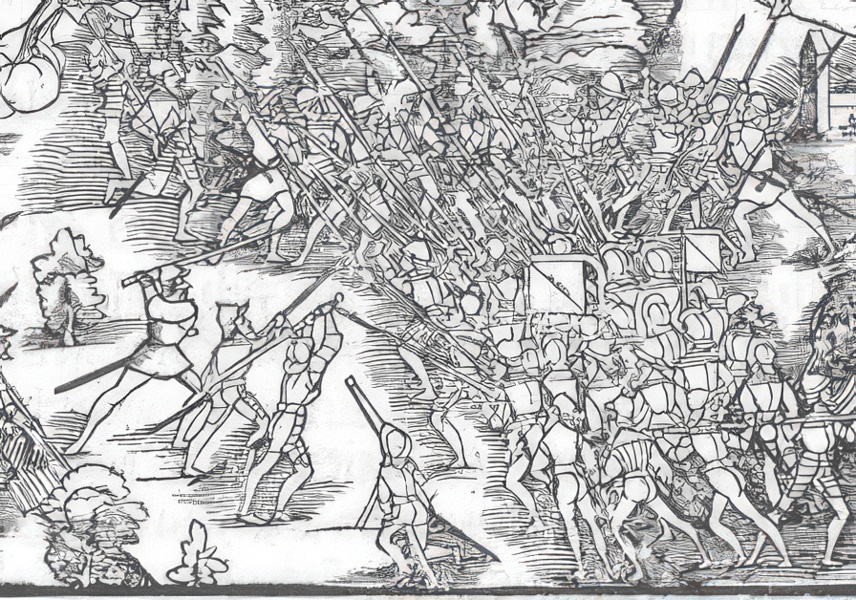Zweihander History: Exploring the German Greatsword’s Origin
NO AI USED This Article has been written and edited by our team with no help of the AI

The Zweihänder is a large two-handed sword that was used mainly in the 16th century. Recognized for its massive long blade with parrying hooks, the zweihänder was the hallmark weapon of the German Landsknechts.
This article delves into the history and origin of these hefty swords.
Defining the Zweihänder

The zweihänder is also known as doppelhänder, beidhänder, bihänder, or bidenhänder, all terms that roughly translate to “two handed” or “double hander” that emerged during the Renaissance Period. The name “Zweihänder” or “Zweyhander” are relatively modern terms.
It is known by different names depending on the region:
- English – Greatsword or two handed sword
- Scottish – Claymore
- Spanish & Portuguese – Montante
- Italians – Spada a due mani
This greatsword is a true two-handed sword (epee a deux main), meaning that it has to be wielded with both hands. They usually range from 4 ft 7 inches (1.4m) in length and weigh about 4.4 lbs (2 kg). Since it is wielded with both hands, the hilt is at least 9.8 inches (25 cm) in length.
Larger versions of the sword that are around 8.8lbs (4 kg) or more are for ceremonial use.
Origin & Development

Experts seem to agree that two-handed swords were first used between 1250 – 1350. While representations in ancient manuscripts are unclear, the gravestone of Renier de Valkenberg, a Teutonic Knight clearly depicts the weapon.
Zweihänder swords are believed to have developed from the longsword or bastard sword of the Late Middle Ages. An intermediate form between the longsword and Zweihänder is seen in the Goliath Fechtbucht, a German fencing manual circa 1510 – 1520.

These swords were the final versions in the trend of large swords that began in the 14th century. Due to its size, it is carried across the shoulder like a halberd. Later versions of the zweihänder had parierhaken (parrying hooks) above the crossguards that serve as a secondary guard to catch other weapons.
Who Created the Zweihänder?
It is often assumed that the zweihänder originated in Switzerland, but there is little to support this. Here are some findings that hint at who might have created the zweihänder
- Switzerland had no iron industry in the early Middle Ages.
- The Swiss had to import arms and armor.
- Out of 16 two-handers dating before 1550 in the Swiss National Museum in Zurich, most are German.
- Smiths from Passau, Solingen, and Munich of South Germany did have the expertise to forge long heavy blades.
- A blade in Vienna dating back to the late 13th century is inlaid with the “wolf mark” of Passau.
For the reasons above, the zweihänder is believed to have been forged by the Germans.
Uses & Roles of the Zweihänder

The Zweihänder is a practical large two-handed great sword of Europe. Despite being considerably heavier, it is an agile weapon that can be deadly for both close combat and battlefield melees.
Designed to be versatile and effective, its primary function is to fight close pike formations in the late 15th and early 16th centuries. Here are some of its uses:
- Blade : Cutting and thrusting
- Hilt : Smashing or pummeling
- Quillons: Hooking the opponent or their weapon
The zweihänder could also chop shafts of opposing weapons and could be used almost like a pole-arm. Unlike longswords, the zweihänder had a specific role as a breaching weapon and was not designed for actual fighting.
History of the Zweihänder
During the 15th and 16th centuries, the German Landsknecht fought in numerous conflicts across Europe, armed with various weapons such as the zweihänder, polearms, and crossbows.
Pier Gerlofs Donia

Pier Gerlofs Donia, also known as Grutte Pier (meaning Big Pier) was a Frisian farmer and freedom fighter. While most of his life is mostly shrouded in legend, the Black Band, a Landsknecht regiment in the service of George, Duke of Saxony plundered Donia’s village, raped and killed his wide, and burnt Donia’s estate and village church to the ground.

Seeking revenge, Grutte Pier started a guerrilla war campaign, aligning with Charles of Egmond, Duke of Guelders. He was known for his ability to wield the zweihänder so efficiently that he beheaded multiple people with a single blow.
Emperor Maximilian & the Landsknechts

In the battles of Morat and Nancy, the Swiss infantry won notable victories. Armed with long pikes, they attacked their enemies in tight phalanx formations. Lacking pike-wielding infantry and a regular army, German Emperor Maximilian I felt threatened by these military developments, so he hired the Landsknecht mercenaries in 1486 to fight for him when required.
The Landsknechts & the Zweihander

Most of the German Landsknechts were pikemen, but the doppelsöldners were experts in wielding the zweihander, smashing their way into enemy ranks.
In the battle of La Bicocca in 1552, the German Landsknechts defeated the Swiss pikemen who were the elites of European battlefields for half a century.
The Decline of Zweihander Swords

By the close of the 16th century, European armies began to rely on gunpowder and abandoned pike formations in battles. This diminished the Landsknechts’ specialty in warfare along with their hallmark zweihänder.
However, they continued to see representative or ceremonial use until the 17th century. Ceremonial versions of the zweihänder were much larger, weighing around 9.9 lbs (4.5 kg) and are also known as Paradeschwert (parade sword) or bearing swords.
Zweihänder Swordsmanship

Throughout history, there are 16 masters and 2 manuscripts that mention the zweihänder. These included:
- Francesco di Sandro Altoni
- Carlo Giuseppe di Grassi
- Achille Marozzo
- Maarten van Heemskerck
- Joachim Meÿer, Pabo de Paredes
- Pedro de la Torre
- And more
The two manuscripts are “Las reglas del montante” and “Sobre el arte de la esgrima.”





